stop start Citroen DS5 2015 1.G Owner's Guide
[x] Cancel search | Manufacturer: CITROEN, Model Year: 2015, Model line: DS5, Model: Citroen DS5 2015 1.GPages: 403, PDF Size: 15.62 MB
Page 103 of 403

101
DS5_en_Chap04_conduite_ed01-2015
Emergency starting with the
"Keyless Entry and Starting"
system
When the electronic key is in the recognition
zone and your vehicle does not start after
pressing the "START/STOP" button:
F
I
nsert the electronic key in the reader.
F
P
ress the brake pedal on vehicles with an
automatic or electronic gearbox, or fully
declutch with a manual gearbox.
F
P
ress the "START/STOP" button.
T
he engine starts. In the event of an emergency only, the engine
can be switched of without conditions. To do
this, press and hold the "START/STOP" button
for about 3 seconds.
In this case the steering column locks as soon
as the vehicle stops.
If the electronic key is no longer in the
recognition zone when driving or when you
(later) request switching off the engine, a
message appears in the instrument panel.
Emergency switch-offElectronic key not recognised by
the "Keyless Entry and Starting"
system
F Press and hold the "START/STOP"
button for about 3 seconds if you want to
force switching off the engine (note that
restarting will not be possible without
the
key).
driving
Page 107 of 403

105
DS5_en_Chap04_conduite_ed01-2015
Emergency braking
The emergency braking must only be used in
exceptional circumstances.If a failure of the DSC system is signalled
by the illumination of this warning lamp,
then braking stability is not guaranteed.
In this event, stability must be assured
by the driver by repeating alternate "pull-
release" actions on the control lever A
.
In the event of a failure of the main
service brake or in an exceptional
situation (e.g. driver taken ill, under
instruction, etc) a continuous pull
on the control lever A will stop the
vehicle.
The DSC system provides stability when
braking during emergency braking.
If the emergency braking malfunctions, the
message "Parking brake control faulty" will be
displayed.
Special situations
To ensure correct operation, and so
your safety, the number of successive
applications and releases of the parking
brake is limited to eight cycles.
If used excessively, you are alerted by
the message "parking brake faulty" and
a flashing warning lamp. In some circumstances (engine start...),
the parking brake may adjust the level
of application itself. This is normal
operation.
To move your vehicle a few centimetres
without starting the engine, with the
ignition on, press the brake pedal and
release the parking brake by pulling
then releasing the control lever A .
Complete release of the parking brake
is indicated by the warning lamps in the
control lever A and in the instrument
panel going off and by the display of the
message "Parking brake off ".
driving
Page 119 of 403

11 7
DS5_en_Chap04_conduite_ed01-2015
You must press the brake pedal when
starting the engine.
Whatever the circumstances, you must
manually apply the parking brake when
parking, unless the parking brake is
programmed in automatic mode.
When immobilising the vehicle, with
the engine running, you must place the
gear lever in neutral N
.
Before carrying out any work in the
engine compartment, check that the
gear lever is in neutral N and that the
parking brake is applied.
Stopping the vehicle
With the ignition on, the flashing of
this warning lamp, accompanied by
an audible signal and a message
in the instrument panel screen,
indicates a malfunction of the
gearbox.
Before switching off the engine, you can
choose to:
-
m
ove to position N to engage neutral,
-
l
eave the gear engaged; in this case, it will
not be possible to move the vehicle.
In both cases, you should apply the parking
brake to immobilise the vehicle, unless it is
programmed in automatic mode.
Operating fault
Sport setting
F After selection of manual or
automated mode, press the
S
button to switch on the Sport
setting, which provides a more
dynamic driving style.
S
appears alongside the gear
engaged in the instrument panel
screen.
F
P
ress the S button again to switch it off.
S
then disappears from the instrument
panel screen.
The Sport setting is switched off every time the
ignition is switched off. Have it checked by CITROËN or a qualified
workshop.
driving
Page 120 of 403
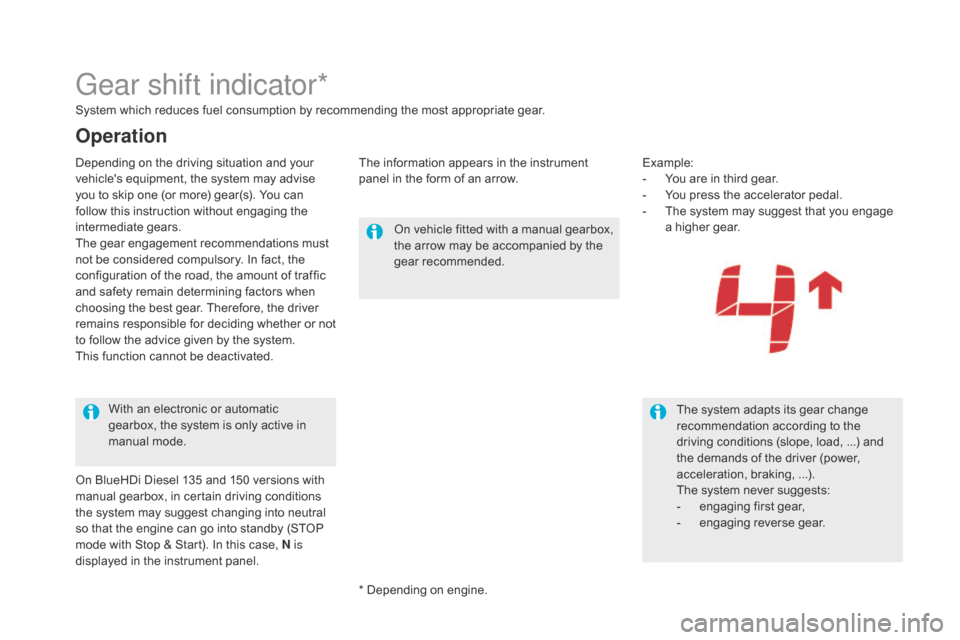
DS5_en_Chap04_conduite_ed01-2015
Gear shift indicator*
System which reduces fuel consumption by recommending the most appropriate gear.The information appears in the instrument
panel in the form of an arrow.Example:
-
Y
ou are in third gear.
-
Y
ou press the accelerator pedal.
-
T
he system may suggest that you engage
a higher gear.
On vehicle fitted with a manual gearbox,
the arrow may be accompanied by the
gear recommended.
The system adapts its gear change
recommendation according to the
driving conditions (slope, load, ...) and
the demands of the driver (power,
acceleration, braking, ...).
The system never suggests:
-
e
ngaging first gear,
-
enga
ging reverse gear.
With an electronic or automatic
gearbox, the system is only active in
manual mode.
Operation
* Depending on engine.
Depending on the driving situation and your
vehicle's equipment, the system may advise
you to skip one (or more) gear(s). You can
follow this instruction without engaging the
intermediate gears.
The gear engagement recommendations must
not be considered compulsory. In fact, the
configuration of the road, the amount of traffic
and safety remain determining factors when
choosing the best gear. Therefore, the driver
remains responsible for deciding whether or not
to follow the advice given by the system.
This function cannot be deactivated.
On BlueHDi Diesel 135 and 150 versions with
manual gearbox, in certain driving conditions
the system may suggest changing into neutral
so that the engine can go into standby (STOP
mode with Stop & Start). In this case, N is
displayed in the instrument panel.
Page 123 of 403
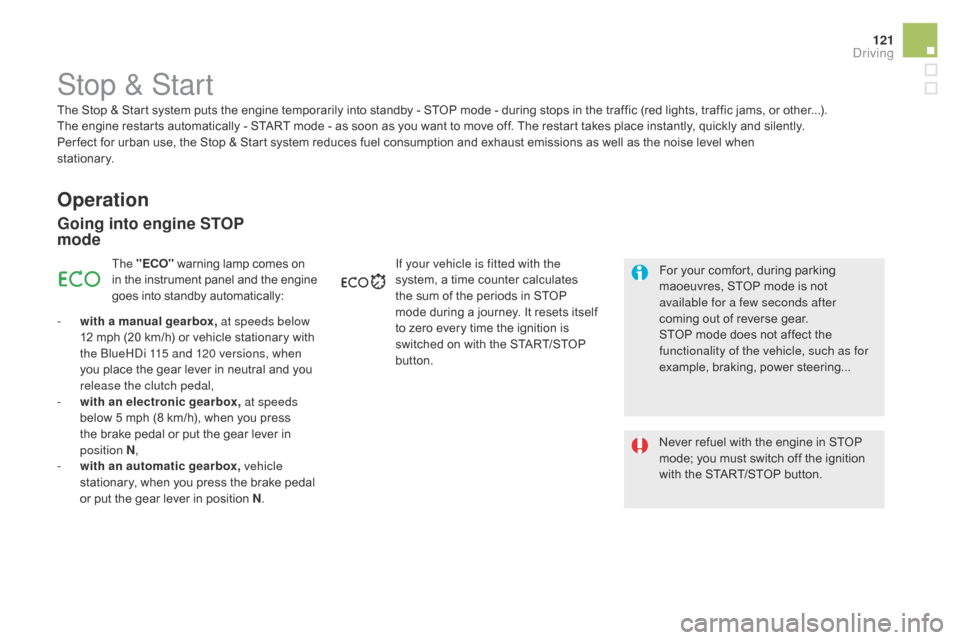
121
DS5_en_Chap04_conduite_ed01-2015
Stop & Start
Operation
Going into engine STOP
mode
The "E cO" warning lamp comes on
in the instrument panel and the engine
goes into standby automatically:
-
w
ith a manual gearbox, at speeds below
12 mph (20 km/h) or vehicle stationary with
the BlueHDi 115 and 120 versions, when
you place the gear lever in neutral and you
release the clutch pedal,
-
w
ith an electronic gearbox, at speeds
below 5 mph (8 km/h), when you press
the brake pedal or put the gear lever in
position
N,
-
w
ith an automatic gearbox, vehicle
stationary, when you press the brake pedal
or put the gear lever in position N .If your vehicle is fitted with the
system, a time counter calculates
the sum of the periods in STOP
mode during a journey. It resets itself
to zero every time the ignition is
switched on with the START/STOP
button.
Never refuel with the engine in STOP
mode; you must switch off the ignition
with the START/STOP button. For your comfort, during parking
maoeuvres, STOP mode is not
available for a few seconds after
coming out of reverse gear.
STOP mode does not affect the
functionality of the vehicle, such as for
example, braking, power steering...
The Stop & Start
system puts the engine temporarily into standby - STOP mode - during stops in the traffic (red lights, traffic jams, or other...).
The
engine restarts automatically - START mode - as soon as you want to move off. The restart takes place instantly, quickly and silently.
Per fect for urban use, the Stop & Start system reduces fuel consumption and exhaust emissions as well as the noise level when
stationary.
driving
Page 124 of 403
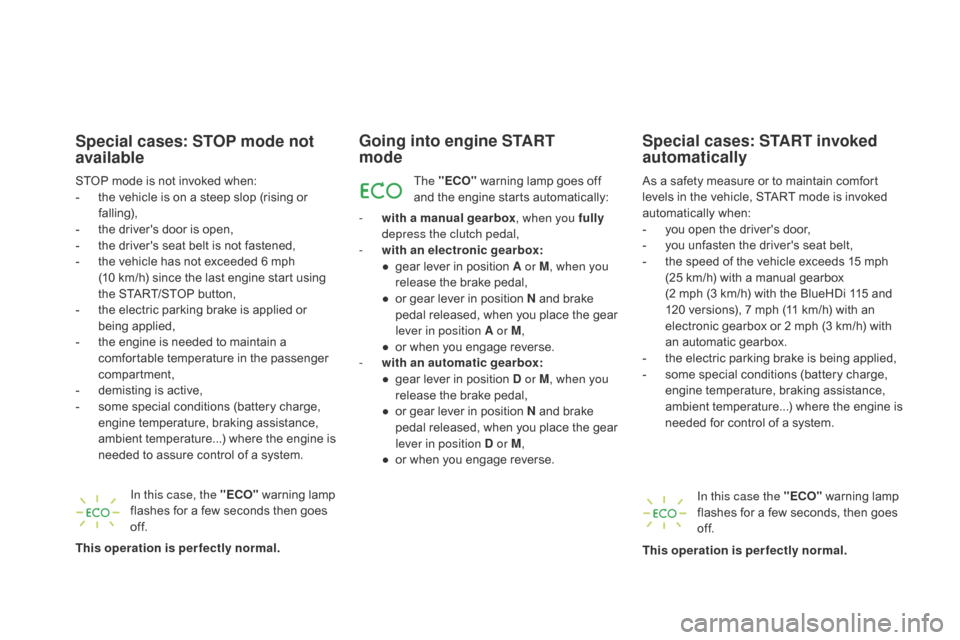
DS5_en_Chap04_conduite_ed01-2015
Special cases: STOP mode not
available
STOP mode is not invoked when:
- t he vehicle is on a steep slop (rising or
falling),
-
t
he driver's door is open,
-
t
he driver's seat belt is not fastened,
-
t
he vehicle has not exceeded 6 mph
(10
km/h) since the last engine start using
the START/STOP button,
-
t
he electric parking brake is applied or
being applied,
-
t
he engine is needed to maintain a
comfortable temperature in the passenger
compartment,
-
d
emisting is active,
-
s
ome special conditions (battery charge,
engine temperature, braking assistance,
ambient temperature...) where the engine is
needed to assure control of a system.
In this case, the "E
c
O
" warning lamp
flashes for a few seconds then goes
of f.
This operation is perfectly normal.
Going into engine START
mode
The "EcO" warning lamp goes off
and the engine starts automatically:
-
w
ith a manual gearbox , when you fully
depress the clutch pedal,
-
w
ith an electronic gearbox:
●
g
ear lever in position A or M , when you
release the brake pedal,
●
o
r gear lever in position N and brake
pedal released, when you place the gear
lever in position A or M ,
●
o
r when you engage reverse.
-
w
ith an automatic gearbox:
●
g
ear lever in position d or M, when you
release the brake pedal,
●
o
r gear lever in position N and brake
pedal released, when you place the gear
lever in position
d or M,
●
o
r when you engage reverse. As a safety measure or to maintain comfort
levels in the vehicle, START mode is invoked
automatically when:
-
y
ou open the driver's door,
-
y
ou unfasten the driver's seat belt,
-
t
he speed of the vehicle exceeds 15 mph
(25 km/h) with a manual gearbox
(2 mph (3 km/h) with the BlueHDi 115 and
120 versions), 7 mph (11 km/h) with an
electronic gearbox or 2 mph (3 km/h) with
an automatic gearbox.
-
t
he electric parking brake is being applied,
-
s
ome special conditions (battery charge,
engine temperature, braking assistance,
ambient temperature...) where the engine is
needed for control of a system.
Special cases: START invoked
automatically
In this case the "EcO " warning lamp
flashes for a few seconds, then goes
of f.
This operation is perfectly normal.
Page 125 of 403

123
DS5_en_Chap04_conduite_ed01-2015
The system is reactivated automatically
at every start using the START/STOP
button.
Reactivation
With the Touch screen tablet system
With the control switch on the
dashboard
If the system has been deactivated
in STOP mode, the engine restarts
immediately.
deactivation
When driving on flooded roads, it is
strongly recommended that the system
be deactivated.
Refer to the "A few driving
recommendations" section.
With the Touch screen tablet system
With the control switch on the
dashboard
F At any time, press the "EcO OFF" control
switch to deactivate the system.
This is confirmed by the illumination of
the indicator lamp in the control switch,
accompanied by the display of a message.
F
Sel
ect the "
dr
iving" menu.
F
I
n the page, press the "E
cO
O
FF" button for Stop & Start. F
P
ress the "E
cO O
FF" control switch again.
The system is active again; this is confirmed by
the indicator lamp in the control switch going
off, accompanied by the display of a message.
F
Sel
ect the "
dr
iving" menu.
The system is active again; this is confirmed by
the indicator lamp in the button going off.
The indicator lamp for this button comes on. F
I
n the page, press the "E
cO
O
FF" button for Stop & Start
again.
driving
Page 126 of 403
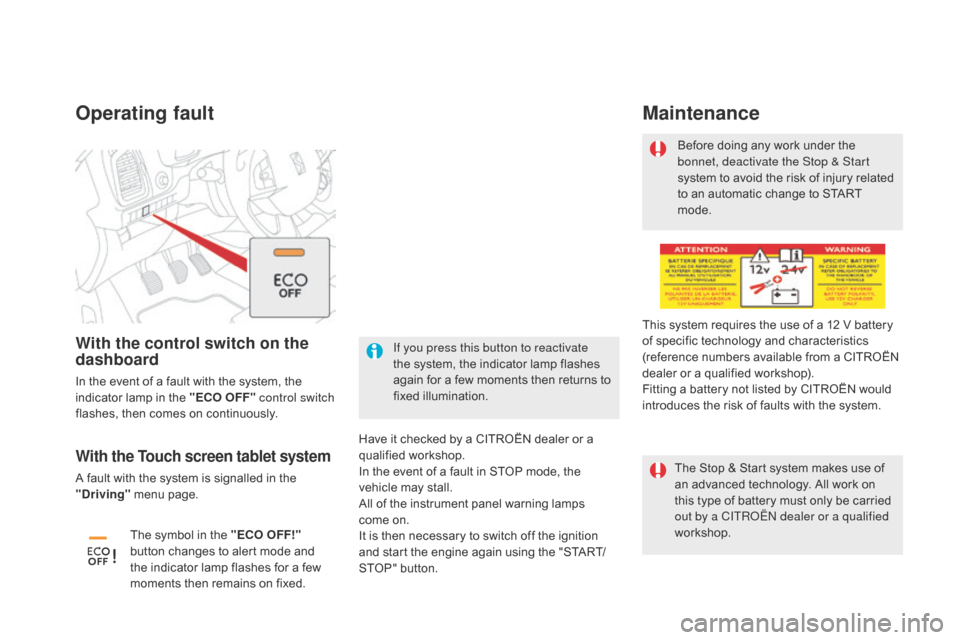
DS5_en_Chap04_conduite_ed01-2015
Operating fault
Have it checked by a CITROËN dealer or a
qualified workshop.
In the event of a fault in STOP mode, the
vehicle may stall.
All of the instrument panel warning lamps
come on.
It is then necessary to switch off the ignition
and start the engine again using the "START/
STOP" button.Before doing any work under the
bonnet, deactivate the Stop & Start
system to avoid the risk of injury related
to an automatic change to START
mode.
This system requires the use of a 12 V battery
of specific technology and characteristics
(reference numbers available from a CITROËN
dealer or a qualified workshop).
Fitting a battery not listed by CITROËN would
introduces the risk of faults with the system.
Maintenance
The Stop & Start system makes use of
an advanced technology. All work on
this type of battery must only be carried
out by a CITROËN dealer or a qualified
workshop.With the Touch screen tablet system
A fault with the system is signalled in the
"dr iving" menu page.
With the control switch on the
dashboard
In the event of a fault with the system, the
indicator lamp in the "EcO O
FF" control switch
flashes, then comes on continuously.
The symbol in the "E
cO
OFF!"
button changes to alert mode and
the indicator lamp flashes for a few
moments then remains on fixed. If you press this button to reactivate
the system, the indicator lamp flashes
again for a few moments then returns to
fixed illumination.
Page 132 of 403

DS5_en_Chap04_conduite_ed01-2015
F With the engine running, press button 1. The
activated/deactivated status when the engine was
switched off is retained when the engine is switched
on again.
The blade retracts automatically 3 seconds after switching
off the engine except in STOP mode of Stop & Start.
Activation / de activation
F With the engine running, adjust the
brightness of the information using
button
3:
-
t
owards the rear to increase the
brightness,
-
t
owards the front to decrease the
brightness.
Brightness adjustment
We recommend that adjustments are
only made using these buttons when
the vehicle is stationary.
When stationary or while driving, no
objects should be placed around the
transparent blade (or on its cover) to
avoid blocking deployment of the blade
and preventing its correct operation.
In certain extreme weather conditions
(rain and/or snow, bright sunshine, ...)
the head-up display may not be legible
or may suffer temporary inter ference.
Some sunglasses may hamper reading
of the information.
To clean the transparent blade, use a
clean, soft cloth (such as a spectacles
cloth or microfibre cloth). Do not use
a dry or abrasive cloth or detergent or
solvent products as these could scratch
the blade or damage the anti-reflection
coating.
Height adjustment
F With the engine running, adjust the display to the required height using button 2 :
-
t
owards the rear to move the display up,
-
t
owards the front to move the display
down.
Page 226 of 403
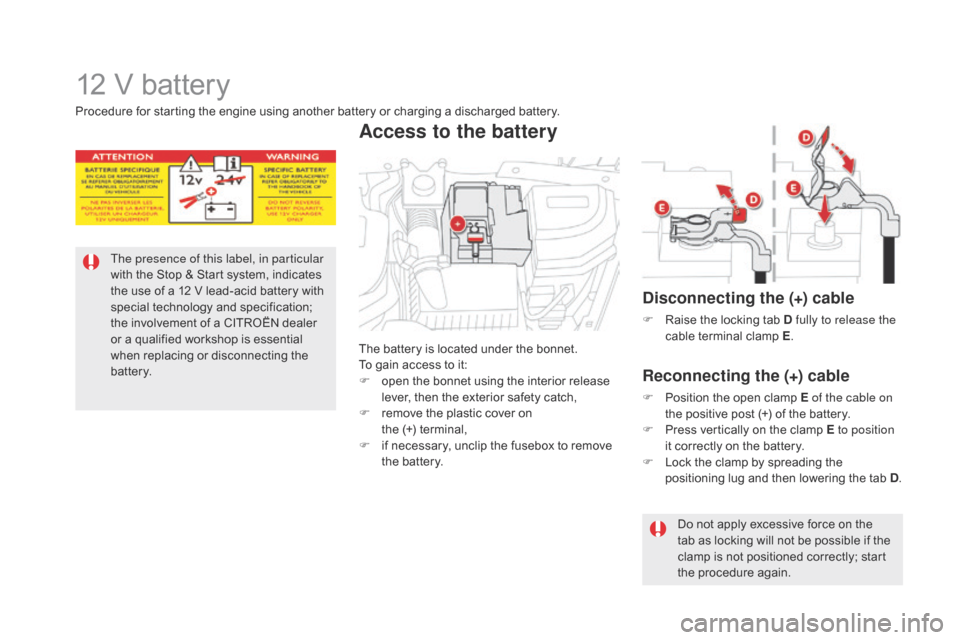
DS5_en_Chap08_info-pratiques_ed01-2015
12 V battery
The presence of this label, in particular
with the Stop & Start system, indicates
the use of a 12 V lead-acid battery with
special technology and specification;
the involvement of a CITROËN dealer
or a qualified workshop is essential
when replacing or disconnecting the
battery.The battery is located under the bonnet.
To gain access to it:
F
o
pen the bonnet using the interior release
lever, then the exterior safety catch,
F
r
emove the plastic cover on
the
(+) terminal,
F
i
f necessary, unclip the fusebox to remove
the battery.
Access to the battery
disconnecting the (+) cable
F Raise the locking tab d fully to release the
cable terminal clamp E.
Reconnecting the (+) cable
F Position the open clamp E of the cable on
the positive post (+) of the battery.
F
P
ress vertically on the clamp E to position
it correctly on the battery.
F
L
ock the clamp by spreading the
positioning lug and then lowering the tab
d
.
D
o not apply excessive force on the
tab as locking will not be possible if the
clamp is not positioned correctly; start
the procedure again.
Procedure for starting the engine using another battery or charging a discharged battery.